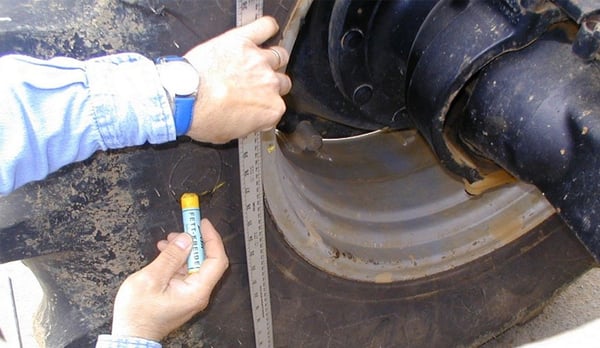How To Repair The Camber On A Craftsman Lawn Tractor
Irregular habiliment to your tractor tyres is an early on warning sign. Whether the tyre is worn on the inside or outside, there is probably a problem with the alignment, which is one of the main adjustment problems in agricultural tyres, which include incorrect parallelism. Parallelism, like camber angle, relates to the incorrect angle of your tractor wheels. Notwithstanding, it is important to understand the deviation between these two alignment problems to make the right adjustments. There are several warning signs for wheel misalignment. Past closely observing your tyres, y'all can detect the problem very speedily. Here are the types of wear that are due to misalignment: These indications could exist caused by other problems, such as the gradient of a field or a route (slant or convex road). Camber can be positive or negative depending on the angle of the tyres in relation to the basis: When talking well-nigh parallelism we speak nearly toe in or toe out depending on the bending to the horizontal beam: Harm to the right side of the tyre tin can exist accentuated in instance of slanting or convex roads, oftentimes found in small land lanes between the fields to facilitate drainage. Whichever option you choose, before using your motorcar again, it is essential to adjust the alignment. To synchronise the parallelism, always refer to the user manual provided by the manufacturer. Mostly, in that location is a small tolerance threshold inside which the tyres will not be damaged. This tolerance ranges from 0 to two mm, whether the tractor is a ii or four-wheel bulldoze. These are the unlike steps to follow to check if your wheels' toe in or toe out is excessive: Professionals will often take these measurements with a laser, which is an increasingly pop and affordable tool. In only a few clicks yous tin detect a discrepancy between the front and rear wheels without moving the vehicle. If you find a problem with the parallelism, you lot must adapt the wheels to accomplish the tolerance threshold. It is appropriate to adapt the parallelism with an opening of 2 mm, to compensate for the constraint to which the front beam is subjected when in use. It is important to bank check your tractor'southward parallelism measurements regularly. Ruts, vibrations, unlevel terrain… can combine on a daily ground to create toe in or toe out progressively, without you noticing. Some small-scale adjustments implemented periodically can salvage you a considerable corporeality of money. The Bridgestone-agriculture.eu web log is written and administered by tractor tyre experts who are bachelor to provide you with the advice you lot demand on the subject of your agricultural tyres. They allow you lot to maximise your productivity with information on all subjects linked to tyres: Technical data for agricultural tyres – Agronomical tyre performance – Air pressure communication – Solutions to avoid soil compaction – Sprayer tyre pressure – Why and how to ballast your tractor tyres – etc… To take it ane step farther and increase the profitability of your farm, les Experts du pneu provide a free, highly detailed eBook which explains the essential function of the agricultural tyre in your productivity.. Nigh people who read this article accept also read some of the following articles:
Over a sure period, this defect can cause up to 30% more wear to the tyres than if the trouble is corrected. This represents a considerable cost for your farm when y'all consider the price of replacing the tyres on your tractor or agricultural equipment.Parallelism or slant bending? How to tell the difference
When facing the tractor, the wheels should be parallel to the tractor's longitudinal axis.
The wheels must be perfectly vertical to the basis to ensure that the tractor grips properly.How to recognise an alignment problem
Simply generally, the alignment needs to be corrected, the lugs are worn down symmetrically, towards the within or the outside, on the right tyre or the left tyre.The different types of defect: camber angle or parallelism
What to do in case of misalignment?
 Equally shortly as yous spot any abnormal wear to your tyres, the first thing to do is to check the alignment.
Equally shortly as yous spot any abnormal wear to your tyres, the first thing to do is to check the alignment.
In cases of misalignment, the front tyres volition by and large clothing down more the rear tyres.
How to synchronise the parallelism?

2d footstep:

Third step:

Fourth footstep:
If the altitude between the 2 dorsum marks is smaller than the distance between the 2 front markings, you lot have toe out.
And if the distance between the ii forepart marks is smaller than that between the two back markings, then you have toe in.
How to adjust the parallelism?
To do this, rotate the steering ball joint slightly.
TIP: bank check your parallelism regularly

Did you like this commodity? Share it:
Source: https://blog.bridgestone-agriculture.eu/how-to-adjust-wheel-alignment-and-avoid-wearing-out-my-tractor-tyres
Posted by: woldforer1983.blogspot.com


0 Response to "How To Repair The Camber On A Craftsman Lawn Tractor"
Post a Comment